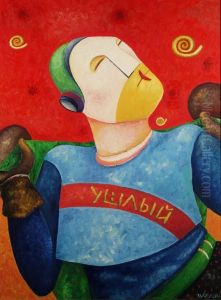Nikolai Andreevich Andreev Paintings
Nikolai Andreevich Andreev was a renowned Russian sculptor and graphic artist, whose contributions to the world of art are celebrated for their emotional depth and innovative techniques. Born on November 5, 1873, in the small village of Vyritsa, near St. Petersburg, Russia, Andreev grew up during a period of significant social and artistic change. His early exposure to the rich cultural heritage of Russia deeply influenced his artistic development.
Andreev's artistic journey began at the St. Petersburg Academy of Arts, where he was trained in classical sculpture. However, his style evolved significantly over the years, incorporating elements of Symbolism and Art Nouveau. He was deeply interested in exploring the human condition, particularly the themes of suffering, spirituality, and redemption, which became recurring motifs in his work.
Throughout his career, Andreev was actively involved in the Russian art scene, participating in several exhibitions and becoming a member of various artistic societies. His works were not only limited to sculpture; he also excelled in graphic arts, creating a number of etchings and lithographs that depicted scenes from Russian life and folklore, as well as portraits of contemporary figures.
The Russian Revolution of 1917 marked a turning point in Andreev's life and career. The ensuing political turmoil and the establishment of the Soviet regime significantly affected the artistic community. Andreev's work, with its focus on personal and spiritual themes, was at odds with the state's push for Socialist Realism. Despite these challenges, he continued to work and adapt, although his opportunities for public commissions diminished.
Nikolai Andreevich Andreev passed away on April 8, 1932, in Leningrad (formerly St. Petersburg), leaving behind a legacy that has continued to influence Russian art. His ability to convey deep emotional resonance and his dedication to exploring the depths of the human soul set his work apart. Today, Andreev's sculptures and graphic works are held in high regard, with several pieces displayed in Russian museums, testament to his enduring impact on the artistic landscape.
